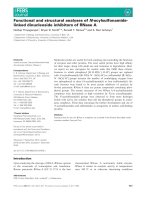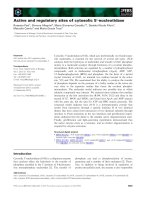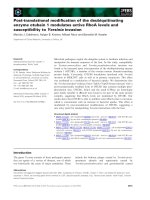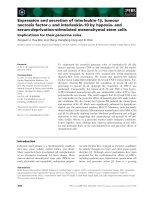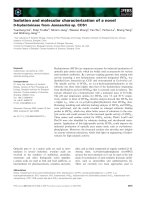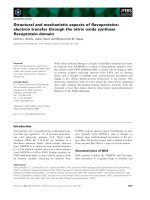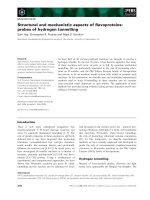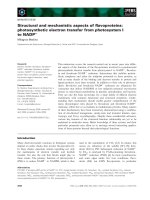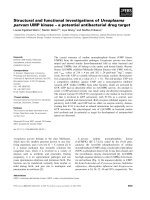Báo cáo khoa học: Expression and physiological role of CCN4⁄Wnt-induced secreted protein 1 mRNA splicing variants in chondrocytes potx
Bạn đang xem bản rút gọn của tài liệu. Xem và tải ngay bản đầy đủ của tài liệu tại đây (433.01 KB, 11 trang )
Expression and physiological role of CCN4⁄ Wnt-induced
secreted protein 1 mRNA splicing variants in chondrocytes
Takeshi Yanagita
1,2
, Satoshi Kubota
1
, Harumi Kawaki
1
, Kazumi Kawata
1
, Seiji Kondo
1
,
Teruko Takano-Yamamoto
3
, Shinji Tanaka
4
and Masaharu Takigawa
1
1 Department of Biochemistry & Molecular Dentistry, Okayama University Graduate School of Medicine, Dentistry and Pharmaceutical
Sciences, Japan
2 Department of Orthodontics and Dentofacial Orthopedics, Okayama University Graduate School of Medicine, Dentistry and Pharmaceutical
Sciences, Japan
3 Division of Orthodontics and Dentofacial Orthopedics, Tohoku University Graduate School of Dentistry, Miyagi, Japan
4 Department of Hepato-Biliary-Pancreatic Surgery, Graduate School of Medicine and Dentistry, Tokyo Medical and Dental University, Japan
The Wnt1-induced secreted proteins (WISPs) were
identified together in a human study reported in 1998
and then later classified as members of the CCN
family, which also includes cysteine-rich 61 (Cyr61 ⁄
CCN1), connective tissue growth factor (CTGF ⁄
CCN2) and nephroblastoma overexpressed (Nov ⁄
CCN3) proteins as its classical members [1–5]. In addi-
tion, prior to the discovery of the human ortholog,
murine CCN4 ⁄ WISP1 was identified as a novel gene
with tumor-suppressor properties and that was initially
Keywords
cartilage; CCN family; chondrocyte
differentiation; splicing variant; Wnt-induced
secreted protein 1 (WISP1)
Correspondence
M. Takigawa, Department of Biochemistry
and Molecular Dentistry, Okayama
University Graduate School of Medicine,
Dentistry and Pharmaceutical Sciences,
2-5-1 Shikata-cho, Okayama 700-8525,
Japan
Fax: +81 86 235 6649
Tel: +81 86 235 6645
E-mail:
Database
The nucleotide sequence data described
have been submitted to the GenBank data-
base under the accession numbers EF025921,
EF025922 and EF025923
(Received 20 November 2006, revised 15
January 2007, accepted 19 January 2007)
doi:10.1111/j.1742-4658.2007.05709.x
CCN4 ⁄ Wnt-induced secreted protein 1 (WISP1) is one of the CCN
(CTGF ⁄ Cyr61 ⁄ Nov) family proteins. CCN members have typical structures
composed of four conserved cysteine-rich modules and their variants lack-
ing certain modules, generated by alternative splicing or gene mutations,
have been described in various pathological conditions. Several previous
reports described a CCN4 ⁄ WISP1 variant (WISP1v) lacking the second
module in a few malignancies, but no information concerning the produc-
tion of WISP1 variants in normal tissue is currently available. The expres-
sion of CCN4 ⁄ WISP1 mRNA and its variants were analyzed in a human
chondrosarcoma-derived chondrocytic cell line, HCS-2 ⁄ 8, and primary rab-
bit growth cartilage (RGC) chondrocytes. First, we found WISP1v and a
novel variant of WISP1 (WISP1vx) to be expressed in HCS-2 ⁄ 8, as well as
full-length WISP1 mRNA. This new variant was lacking the coding regions
for the second and third modules and a small part of the first module. To
monitor the expression of CCN4 ⁄ WISP1 mRNA along chondrocyte differ-
entiation, RGC cells were cultured and sampled until they were mineral-
ized. As a result, we identified a WISP1v ortholog in normal RGC cells.
Interestingly, the WISP1v mRNA level increased dramatically along with
terminal differentiation. Furthermore, overexpression of WISP1v provoked
expression of an alkaline phosphatase gene that is a marker of terminal dif-
ferentiation in HCS-2 ⁄ 8 cells. These findings indicate that WISP1v thus
plays a critical role in chondrocyte differentiation toward endochondral
ossification, whereas HCS-2 ⁄ 8-specific WISP1vx may be associated with the
transformed phenotypes of chondrosarcomas.
Abbreviations
ALP, alkaline phosphatase; CT, C-terminal cysteine knot; HUVEC, human umbilical vein endothelial cell; IGFBP, insulin-like growth factor
binding protein-like; RGC, rabbit growth cartilage; TSP1, thrombospondin type 1; VWC, von Willebrand factor type C; WISP, Wnt-induced
secreted protein.
FEBS Journal 274 (2007) 1655–1665 ª 2007 The Authors Journal compilation ª 2007 FEBS 1655
described as ‘Expression in low-metastatic cells type 1
(Elm1)’ gene [6].
Currently, all six members tend to be referred to as
CCN1–6, based on the unified nomenclature [1,7].
Members have been described as being involved in a
variety of cell biological processes, such as apoptosis,
mitosis, cell adhesion, the production of extracellular
matrix and angiogenesis [2,8–12]. It should be noted
that most have unfavorable roles in human fibrotic dis-
orders and several types of malignancy [13]. As seen in
the other CCN family members, CCN4 ⁄ WISP1 posses-
ses a typical structure composed of four conserved cys-
teine-rich modular domains encoded by separate exons
[14], which share sequence homologies with the insu-
lin-like growth factor binding protein (IGFBP: first),
von Willebrand factor type C repeat (VWC: second),
thrombospondin type 1 repeat (TSP1: third), and the
C-terminal cysteine knot (CT: fourth), respectively.
The multimodular architecture of WISP1, along with
the production of its truncated isoforms in tumors, rai-
ses interesting questions regarding the participation of
each individual module in the various biological func-
tions of this factor [15].
The involvement of CCN4 ⁄ WISP1 in malignant neo-
plasms has been relatively well investigated [16]. In ear-
lier studies, full-length WISP1 was also shown to restrain
tumor growth and metastasis, as represented by its initial
name, Elm1 [6]. Recently, a novel variant of WISP1
(WISP1v), which lack the VWC module, was reported in
a few in human gastrointestinal cancer tissues, thus sug-
gesting the involvement of the variant in malignant phe-
notypes of certain cancers [17–20]. However, because of
its initial discovery in mouse melanoma, no investigation
was performed to clarify the distribution of WISP1 and
its physiological roles in normal tissues.
In this study, we analyzed the expression of full-
length WISP1 mRNA and its splicing variants in nor-
mal and malignant-transformed chondrocytes. For the
first time, we describe the expression of WISP1v in nor-
mal growth plate chondrocytes, which was regulated
along with the terminal differentiation of those cells.
Furthermore, we also identified a novel WISP1 mRNA
variant in malignant-transformed human chondrocytes.
The roles of these variants in chondrocyte biology have
been analyzed and are now discussed.
Results
CCN4 ⁄ WISP1 mRNA splicing variants in human
chondrocytic HCS-2/8 cells
To characterize mRNAs from ccn4 ⁄ wisp1, RT-PCR
was performed using total RNAs from HCS-2 ⁄ 8,
human umbilical vein endothelial cells (HUVEC),
HeLa, MDA231, SaOS2 and HEK293 cells with speci-
fic primers that recognize the IGFBP (sense) and CT
(antisense) coding exons. These primers were designed
to amplify the splicing variant lacking the VWC mod-
ule area (WISP1v), as well as full-length WISP1
(Fig. 1A). As a result, no ccn4 ⁄ wisp1 transcripts were
Fig. 1. Analysis of CCN4 ⁄ WISP1 mRNA in several cell lines as evaluated by RT-PCR. (A) The sense and antisense primers were designed to
recognize the sequences in IGFBP module-encoding exons and CT module-encoding exons, respectively. The length of the PCR products
from the full-length CCN4 ⁄ WISP1 amplified by these primers was expected to be 606 bp. (B) The results of the RT-PCR analysis.
CCN4 ⁄ WISP1 and WISP1v-cloned vectors were also amplified as controls. According to the DNA size markers analyzed together, the size of
the PCR product I was 600 bp, whereas those of II and III were 400 and 200 bp, respectively. Experiments were repeated at least three
times and representative results are shown. Equal sample load was confirmed by the RT-PCR analysis of gapdh mRNA.
CCN4 splicing variants in chondrocytes T. Yanagita et al.
1656 FEBS Journal 274 (2007) 1655–1665 ª 2007 The Authors Journal compilation ª 2007 FEBS
detected with kidney-derived HEK293, HeLa cervical
cancer and MDA231 breast cancer cells. Vascular
endothelial cells (HUVEC) and A371 melanoma cells
expressed only full-length mRNA (Fig. 1B), whereas
osteoblastic SaOS2 expressed both CCN4 ⁄ WISP1 and
WISP1v. Interestingly, we obtained three distinct
amplicons from the chondrocytic HCS-2 ⁄ 8 mRNA.
Subsequent nucleotide sequence analysis revealed that
the longest and intermediate bands were full-length
CCN4 ⁄ WISP1 and WISP1v, respectively. However,
the shortest band was a novel variant of WISP1
(WISP1vx) not previously described (Fig. 2A). In addi-
tion, the presence of WISP1v in human osteogenic cell
lines was also revealed for the first time.
Structure and predicted translation product of
the novel CCN4/WISP1 mRNA splicing variant,
WISP1vx
According to sequence analysis data, this novel vari-
ant, WISP1vx, lacks VWC and TSP module-coding ex-
ons and part of the IGFBP module-coding exon.
Because the alternative splicing site in IGFBP is
located slightly upstream of the authentic site, the IG-
FBP-coding exon in WISP1vx was 23 bp shorter than
the full-length exon. However, owing to the frame-
shift, the IGFBP⁄ CT fusion coding frame is not trans-
lated properly after the alternative splice site (Fig. 2A).
The deduced protein from WISP1vx is a single IGFBP
module, in which eight C-terminal authentic amino
acid residues are removed, and an extra 14 residues are
added in their place.
Importantly, the nucleotide sequences of exon–
intron boundaries of WISP1vx strictly conserve the
general rule of mRNA splicing sites in higher eukaryo-
tes (Fig. 2B). These findings indicate that WISP1vx is
not an artifact of PCR amplification, but a splicing
variant uniquely present in HCS-2 ⁄ 8 chondrocytic
cells.
Detection of CCN4 ⁄ WISP1 proteins in HCS-2/8
cells
In order to examine whether CCN4 ⁄ WISP1 and
WISP1v mRNAs yielded corresponding proteins in
HCS-2 ⁄ 8 cells, we analyzed the HCS-2 ⁄ 8 cell lysate
using western blotting with an anti-(CCN4 ⁄ WISP1)
serum targeting the CT module. First, mammalian
expression vectors for FLAG epitope-tagged CCN4 ⁄
WISP1, WISP1v and WISP1vx proteins were con-
structed, and the proteins were overexpressed by
DNA transfection of these expression vectors
(Fig. 3A) into HCS-2 ⁄ 8 cells. The overexpressed
CCN4 ⁄ WISP1, WISP1v and WISP1vx served as pos-
itive controls for western blotting. Because the FLAG
epitope itself is a small octapeptide, the exogenesis
CCN4 ⁄ WISP1 and its variants are indistinguishable
from endogenous ones on SDS⁄ PAGE. As shown in
Fig. 3B, analysis of transfectants with the anti-
(CCN4 ⁄ WISP1) clearly showed strong enhancement
of the CCN4 ⁄ WISP1 and WISP1v signals that were
also present in HCS-2 ⁄ 8 cells without the overexpres-
sion. As expected, no WISP1vx signal was detected,
because it lacked the CT module in which the epitope
of H-55 antibody was located. In contrast, when we
used anti-FLAG IgG, we detected CCN4 ⁄ WISP1,
WISP1v and WISP1vx only in overexpressed cells at
the expected electromobility. This indicates that
A
B
Fig. 2. Exon–intron boundaries and the putative translation products
of the novel variant (WISP1vx). (A) Nucleotide sequences of the
amplicons I, II and III from HCS-2 ⁄ 8 cDNA were analyzed and the
structures of the corresponding mRNAs and deduced translational
products are illustrated. Owing to the alternative splicing, a frame-
shift mutation was introduced, thus resulting in a premature termin-
ation of the translation (III), as detailed in Fig. 2B. (B) Genomic,
mRNA and the deduced amino acid sequences are displayed at
upper, middle and lower, respectively. Alternative and authentic spli-
cing sites are indicated with an emphasis of consensus sequences.
Owing to the frame-shift mutation, a stop codon appears at the
fifteenth codon downstream of the alternatively splice site. SD and
SA denote splicing donors and acceptors, respectively.
T. Yanagita et al. CCN4 splicing variants in chondrocytes
FEBS Journal 274 (2007) 1655–1665 ª 2007 The Authors Journal compilation ª 2007 FEBS 1657
CCN4 ⁄ WISP1 and WISP1v proteins were actually
translated from CCN4 ⁄ WISP1 and WISP1v mRNAs
in HCS-2 ⁄ 8 cells.
A rabbit ortholog of the reported CCN4/WISP1-
splicing variant (WISP1v) that is associated with
human malignancies
HCS-2 ⁄ 8 was derived from a human chondrosarcoma
and it is one of the cell lines known to retain the
characters of chondrocytes, as represented by the
expression of type II and type X collagen genes. To
assess whether WISP1v and WISP1vx are associated
with malignant phenotypes, or with normal chondro-
cytic phenotypes, we investigated whether CCN4 ⁄
WISP1 mRNA and its variants are also expressed in
normal primary chondrocytes. Rabbit growth carti-
lage (RGC) cells were isolated, and chondrocytic
differentiation was induced in vitro. Thereafter, RT-
PCR was performed to analyze the ccn4 ⁄ wisp1
mRNA expression pattern in RGC cells. Interestingly,
WISP1v, as well full-length CCN4 ⁄ WISP1 mRNA,
was distinctly detected in normal RGC, whereas
WISP1vx was not. As summarized in Fig. 4, nucleo-
tide sequence analysis indicated that the splicing sites
used to generate rabbit WISP1v are at the same posi-
tion as those observed in the human gene, indicating
that it is exactly the same ortholog as that of human
WISP1v.
Regulated expression of WISP1v along with the
chondrocytic differentiation of RGC cells
In order to assess whether WISP1v is associated with
the development of growth cartilage, primary growth
cartilage cells collected from rabbits were cultured until
they became confluent. Afterwards, a long-term culture
for the induction of terminal differentiation was car-
ried out for over one month. Fluctuation in type II
collagen as a marker gene of chondrocyte differenti-
ation showed that RGC cells were properly differenti-
ated in vitro (Fig. 5C). Alizarin red staining of RGC
cells revealed increased mineralization by the cells from
2 weeks after reaching confluency (Fig. 5A). Interest-
ingly, the expression level of WISP1v increased gradu-
ally along with the mineralization of chondrocytes
(Fig. 5D,E), thus suggesting that WISP1v plays a spe-
cific role therein. In contrast, full-length CCN4 ⁄ WISP1
was observed to be expressed almost constantly
throughout all stages of chondrocyte differentiation
(Fig. 5D), thus implying a more basic biological role
for full-length CCN4 ⁄ WISP1 mRNA in growth plate
chondrocytes.
Distribution of CCN4/WISP1 proteins in growth
cartilage in vivo
In general, the distribution of a protein in a certain tis-
sue is closely associated with its function in vivo.
Fig. 3. Production of the WISP1v proteins in HCS-2 ⁄ 8 cells and their overexpression. (A) Molecular constructs for the overexpression of
WISP1, WISP1v and WISP1vx. A mammalian expression vector, pFLAG-CMV was employed as the parental vector. The resultant constructs
are illustrated. These plasmids were designed to express WISP1, WISP1v and WISP1vx with the FLAG epitopes at the N-termini. (B) West-
ern blotting analysis probed by anti-(human CCN4 ⁄ WISP1) serum (left), or anti-FLAG serum (right) with the lysate of HCS-2 ⁄ 8 cells, together
with those overexpressing WISP1, WISP1v, WISP1vx. Apparent molecular masses of specific signals in SDS ⁄ PAGE are shown. Positions of
molecular mass markers are shown in the middle. Specific signals are marked by arrows. Experiments were repeated twice, yielding com-
parable results.
CCN4 splicing variants in chondrocytes T. Yanagita et al.
1658 FEBS Journal 274 (2007) 1655–1665 ª 2007 The Authors Journal compilation ª 2007 FEBS
Fig. 4. The expression of WISP1v orthologue in normal RGC cells and its structure. (A) The detection of WISP1v as well as CCN4 in RGC
cells. Total RNA from RGC cells (right) that had been cultured 3 weeks at confluence was analyzed. The expected sizes of the amplicons
were 550 bp from rabbit CCN4 ⁄ WISP1 and 289 bp from rabbit WISP1v, respectively, which were consistent with the electromobility seen
here (left). A representative result of four independent series of experiments with similar results is displayed. (B) Detailed structure of the
exon–intron boundary of rabbit WISP1v in comparison with human WISPv.
Fig. 5. Regulated expression of WISP1v along with chondrocytic differentiation. RGC cells were differentiated in vitro, and the expression of
a marker gene and WISP1v was analyzed along with the time course. (A) Alizarin red staining of RGC cells representing mineral deposition.
(B) Agarose gel electrophoresis analysis confirming the quality of the total RNA at each stage. (C) Expression of the type II collagen gene as
evaluated by quantitative real-time PCR. (D) RT-PCR analysis with the primers recognizing WISP1v. (E) A quantitative real-time PCR analysis
performed with rabbit-specific WISP1v primers. The sampling time points are represented as the numbers of weeks after the cell
reached confluence. Representative results of four independent series of experiments are displayed with error bars (SD of real-time PCR
evaluation).
T. Yanagita et al. CCN4 splicing variants in chondrocytes
FEBS Journal 274 (2007) 1655–1665 ª 2007 The Authors Journal compilation ª 2007 FEBS 1659
Therefore following mRNA analysis, we examined the
distribution of CCN4 ⁄ WISP1 and WISP1v proteins in
developing mouse growth cartilage by immunohisto-
chemistry (Fig. 6). Because no anti-(CCN4 ⁄ WISP1)
serum was able to detect the loss of VWC, which is
the structural determinant of WISP1v that distingui-
shes it from full-length WISP1 mRNA, we used an
antibody that recognized a common module between
the full-length CCN4 ⁄ WISP1 mRNA and WISP1v
proteins. As a result, positive signals representing full-
length CCN4 ⁄ WISP1 mRNA and WISP1v were
observed, and were particularly strong in the hyper-
trophic zone of the developing tibial sections of the
mouse embryo. Although these signals also include
those from the full-length CCN4 ⁄ WISP1 mRNA, these
in vivo findings are consistent with the total outcome
of the constitutive expression of the full-length and the
differentiation stage-dependent expression of WISP1v
in vitro.
Effect of overexpression of CCN4/WISP1 and its
variants on the phenotypes of human
chondrocytic HCS-2 ⁄ 8 cells
Finally, the biological function of WISP1v and
WISP1vx was evaluated using overexpression experi-
ments. FLAG epitope-tagged WISP1v and WISP1vx
were overexpressed by DNA transfection of mamma-
lian expression vectors into HCS-2 ⁄ 8 cells. First, over-
expression of WISP1v and WISP1vx was confirmed by
western blotting with anti-FLAG IgG (Fig. 3B).
Thereafter, we collected total RNA and comparatively
analyzed the expression levels of the marker genes of
chondrocyte differentiation and mineralization by real-
time quantitative RT-PCR. No significant difference
was observed in the mRNA level of type II collagen
and aggrecan core protein genes; however, the alkaline
phosphatase (ALP) mRNA level increased remarkably
with WISP1v overexpression (Fig. 7).
Discussion
In this study, we obtained some clues to clarify the
physiological roles of WISP1v in normal cells. In par-
Fig. 6. Immunohistochemical staining of CCN4 ⁄ WISP1 and WISP1v
in the developing tibia of a mouse embryo. The tibia at embryonic
day of 17 was probed using anti-(CCN4 ⁄ WISP1) serum recognizing
the CT module. Dark brown signals indicate the presence of
CCN4 ⁄ WISP1 and ⁄ or WISP1v protein (right). A negative control
without primary antibody is also shown (left). Cartilaginous ECM
was counterstained by methyl green.
Fig. 7. Effects of the overexpression of WISP1v and WISP1vx in HCS-2 ⁄ 8 on the differentiation marker genes of growth plate chondrocytes.
Quantitative real-time PCR analysis was performed with WISP1v and WISP1vx overexpressing HCS-2 ⁄ 8 cells. The relative values against
the expression of gapdh were computed and displayed with error bars (SD). Data are derived from three independent evaluations. Statistical
analysis was performed by Tukey–Kramer test. *P<0.05, significantly different as indicated by the bracket.
CCN4 splicing variants in chondrocytes T. Yanagita et al.
1660 FEBS Journal 274 (2007) 1655–1665 ª 2007 The Authors Journal compilation ª 2007 FEBS
ticular, expression of WISP1v among normal chondro-
cytes and osteoblastic cells was confirmed, which has
heretofore not been elucidated. Expression of WISP1v
increased during the course of chondrocytic terminal
differentiation, thus suggesting a role for WISP1v
therein. This hypothesis was supported by the fact that
overexpression of WISP1v enhanced the gene expres-
sion of one of the mineralization markers in chondro-
cytic cells. Moreover, the presence of a novel splicing
variant not described previously was discovered in
HCS-2 ⁄ 8 cells. These findings are summarized in
Fig. 8.
To date, WISP1v has been investigated only from
the point of view of tumorigenesis and malignant phe-
notypes of tumors [16]. Indeed, expression of WISP1v
has been reported only in malignant tumor cells [7,17].
Scirrhous carcinoma of the stomach is known to be
associated with WISP1v and it is characterized by
rapid growth with a vast fibrous stroma, high invasive-
ness and a substantially poor prognosis [20]. Because
little is known about the molecular pathogenesis of the
disease, a pathological role for WISP1v should be
investigated further. It should be noted that most
CCN family members are associated with certain types
of malignancy.
Regarding physiological functions, some CCN fam-
ily members play an important role in skeletal growth,
as typically represented by CCN2 ⁄ CTGF [1,4,5].
CCN2 ⁄ CTGF was found to be highly expressed in
hypertrophic chondrocytes, as shown by in situ hybrid-
ization of both whole-mount neonates and their longi-
tudinal sections [21]. A series of in vitro evaluations
revealed that CCN2 ⁄ CTGF plays an important role in
cartilage formation and endochondral ossification.
RGC and rabbit articular cartilage cells transfected
with recombinant adenoviruses generating mRNA for
CCN2 ⁄ CTGF, thus result in increased proteoglycan
synthesis [22,23]. Moreover, rCCN2 ⁄ CTGF effectively
increased both the ALPase activity and the matrix cal-
cification of RGC cells [24,25]. In the developing skel-
etal system, CCN1 ⁄ Cyr61 is expressed in the cartilage
of a number of skeletal elements. Regarding these ele-
ments, CCN1 ⁄ Cyr61 is first expressed in condensing
mesencymes, with expression persisting throughout the
stages of chondrogenesis [26]. Strong expression of
CCN1 ⁄ Cyr61 in the developing cardiovascular and
skeletal systems suggests that it might play an import-
ant role in angiogenesis and⁄ or chondrogenesis [27–
31]. In contrast, no report has described the role of
CCN4 ⁄ WISP1 in cartilage development and endochon-
dral ossification. Here, we showed for the first time the
expression and possible function of the CCN4 ⁄ WISP1
variant at a late stage of endochondral ossification. In
addition to the effect on ALP gene expression, we also
evaluated the effect of WISPv overexpression on
type X collagen gene expression, but no significant
effect was observed (data not shown). Together with
the fact that osteoblastic cells also expressed WISP1v,
this variant is thought to play a role in mineralization
rather than hypertrophy of chondrocytes.
In comparison with CCN1 ⁄ Cyr61 and CCN2 ⁄
CTGF, the role of CCN4 ⁄ WISP1 in chondrocyte dif-
ferentiation appears more specific to the mineralizing
stage of endochondral ossification. This fundamental
difference may be interpreted from an evolutionary
point of view. Genome-wide prediction of CCN ortho-
logs in several species indicated that CCN4 ⁄ WISP1 or-
thologs were found only in animals with a calcified
skeleton, whereas CCN1 ⁄ Cyr61 and CCN2 ⁄ CTGF
could be identified in invertebrates such as Ciona intes-
tinalis. Thus, CCN4 ⁄ WISP1 is thought to be required
for the establishment of a calcified endoskeleton. This
hypothesis is consistent with our findings on WISP1v.
However, it may not apply exactly to full-
length CCN4 ⁄ WISP1, because no clear change was
observed according to the chondrocytic differentiation.
Fig. 8. Formation and function of
CCN4 ⁄ WISP1 variants. Structure, expres-
sion and function of the CCN4 ⁄ WISP1 vari-
ants are summarized. All of the findings
were obtained in this study except for that
of gastrointestinal cancers reported by Tan-
aka et al. [17,20]. ++, enhanced expression
evaluated by real-time RT-PCR; ±, modest
expression evaluated by real-time RT-PCR;
–, expression undetectable.
T. Yanagita et al. CCN4 splicing variants in chondrocytes
FEBS Journal 274 (2007) 1655–1665 ª 2007 The Authors Journal compilation ª 2007 FEBS 1661
In addition, no substantial induction of ALPase activ-
ity was seen in the overexpression experiment (data
not shown). We suspect that full-length CCN4⁄ WISP1
does not have such a close relationship with endochon-
dral mineralization, but rather another basic cell biolo-
gical role in chondrogenesis may exist. In fact, our
preliminary data indicate the increasing expression of
CCN4 ⁄ WISP1 end ⁄ or its variant along with chondro-
genesis of mesenchymal stem cells (Kawaki et al.,
manuscript in preparation).
The functional significance of WISP1vx remains to be
investigated. Expression of WISP1vx was detected only
in chondrosarcoma-derived HCS-2 ⁄ 8 cells. We are cur-
rently collecting clinical samples of chondrosarcomas to
verify the significant relationship between WISP1v
expression and phenotypes of particular type of malig-
nancy. Further functional evaluations are also required
to elucidate the pathological roles of this variant.
Experimental procedures
Cell culture
A human chondrosarcoma-derived chondrocytic cell line,
HCS-2 ⁄ 8 [32], human cervical carcinoma-derived HeLa,
human melanoma cell line A371, human osteoblastic SaOs2
and human embryonic kidney-derived HEK293 [33] cells
were grown in DMEM supplemented with 10% fetal
bovine serum. HUVECs derived from human umbilical
cords were purchased from Biowhittaker (Walkersville,
MD) and used between passages three and seven. These
cells were cultured in EBM-2 complete medium (Clonetics,
San Diego, CA). RGC cells were isolated from growth car-
tilage in ribs of 5-week-old rabbits, as described previously
[25]. The primary RGC cells were cultured in a-modifica-
tion of minimum essential medium (Sigma, St Louis, MO)
containing 10% fetal bovine serum. Cell cultures were
maintained in a humidified 5% CO
2
atmosphere at 37 °C
without any passage until analysis.
Alizarin red staining
RGC cells in six-well plates were washed with NaCl ⁄ P
i
and
fixed using 4% paraformaldehyde ⁄ NaCl ⁄ P
i
. Following fix-
ation cells were washed again in NaCl ⁄ P
i
and stained with
a 1% alizarin red solution, as described previously [34].
Macroscopic images were captured after 15 extensive
washes with NaCl ⁄ P
i
.
DNA transfection
HCS-2 ⁄ 8 cells were seeded onto six-well plates at 500 000
cells per well. Cells were transfected with 2 lg of plasmid
DNA using 8 lL of FuGENE6 transfection reagent (Roche
Applied Science, Penzberg, Germany) according to the
manufacturer’s instructions. Cells were lysed in 50 lLof1·
passive lysis buffer (Promega, Madison, WI), and collected
for western blotting at 48 h after transfection. RNA was
also extracted from cells for RT-PCR at 48 h after transfec-
tion.
RNA extraction and RT-PCR analysis
Total RNA was extracted from the cells using the RNeasy
kit, according to the manufacturer’s instructions (Qiagen,
Valencia, CA). Total RNA (500 ng) was reverse-transcribed
to cDNA by using an oligo(dT) with avian myeloblastosis
virus reverse transcriptase (Takara, Tokyo, Japan). For
semiquantitative PCR analysis, the cDNAs were amplified
with Blend-Taq Plus (Toyobo, Osaka, Japan) with a regular
thermal cycler.
The sets of synthetic primers used for amplification are
described below, where the numbers in parentheses indicate
the expected sizes of the PCR products: human glyceralde-
hyde-3-phosphate dehyrogenase gene (gapdh), sense 5¢-GCC
AAAAGGGTCATCATCTC-3¢ and antisense 5¢-GTCTTC
TGGGTGGCAGTGAT-3¢ (215 bp); human ccn4 ⁄ wisp1,
sense 5¢-CTCAGCAGCTTGGGGACAAC-3¢ and antisense
5¢-GATGCCTCTGGCTGGTACAC-3¢ (606 bp); rabbit
ccn4 ⁄ wisp1, sense 5¢-ATCGGGGCCTCTACTGCGACTA
CAG-3¢ and antisense 5¢-TGGCTGGTACACAGCCAGA
CACTTC-3¢ (550 bp); human wisp1v, sense 5¢-GCAATAG
GAGTGTGTGCACAGGTGG-3¢ and antisense 5¢-GAT
GCCTCTGGCTGGTACAC-3¢ (345 bp). The amplification
conditions were as follows: for human ccn4 ⁄ wisp1 and
human wisp1v cDNA, 94 °C (5 min) for 1 cycle, followed
by 94 °C (30 s), 65 °C (30 s), 72 °C (45 min) for 35 cycles,
and a final incubation at 72 °C for 5 min; for rabbit
ccn4 ⁄ wisp1 and rabbit wisp1v cDNAs, 94 °C (5 min) for
1 cycle, followed by 94 ° C (30 s), 60 °C (30 s), 72 ° C (30 s)
for 35 cycles, and a final incubation at 72 °C for 5 min.
PCR products were electrophoresed in a 1% agarose gel
containing ethidium bromide and visualized under UV
light. Photographs of the stained gels were taken and
analyzed quantitatively with transilluminator fasiii
(Toyobo).
Antibodies and molecular clones
An anti-(CCN4 ⁄ WISP1 H-55) serum recognizing the CT
module (Santa Cruz Biotechnologies, Santa Cruz, CA) and
an anti-(FLAG M2) mAb (Sigma) were utilized in western
blotting or immunohistochemistry.
For molecular cloning of wisp1-related cDNA fragments,
PCR products were fractionated by agarose gel electrophor-
esis and were extracted from the gels using the Gel Extrac-
tion kit (Qiagen). Next, purified PCR products were
inserted into pGEM T-easy vector according to the manu-
facturer’s instructions (Promega).
CCN4 splicing variants in chondrocytes T. Yanagita et al.
1662 FEBS Journal 274 (2007) 1655–1665 ª 2007 The Authors Journal compilation ª 2007 FEBS
The original human CCN4 ⁄ WISP1 and WISP1v mam-
malian expression vectors were given by Shinji Tanaka
(Tokyo Medical and Dental University), in which human
cDNAs were inserted in pCR3.1 (Invitrogen, San Diego,
CA) [17]. Three FLAG epitope-tagged expression vectors
were newly constructed.
ccn4 ⁄ wisp1 and wisp1v cDNAs were excised from the
pCR3.1-based plasmids by digestion with HindIII and
XbaI, and then inserted between the corresponding restric-
tion enzymatic sites of the Mammalian Amino-Terminal
FLAG
Ò
vector (Sigma). The resultant expression plasmids
contain the ccn4 ⁄ wisp1 and its variant cDNAs fused in-
frame to the FLAG epitope tag. We designated these plas-
mids CMV-FLAG–WISP1, CMV-FLAG–WISP1v and
CMV-FLAG–WISP1vx, respectively, and utilized them in
the overexpression experiments.
DNA sequence analysis
The nucleotide sequences of the cloned PCR products and
newly constructed expression plasmids were determined by
automated fluorescence DNA sequencing using the ABI
Prism Dye Terminator Cycle Sequencing Kit (PE Applied
Biosystems, Foster City, CA), following the manufac-
turer’s recommendations. The primer recognizing the bac-
teriophage T7 promoter was employed in the sequencing
reactions for the TA-cloned cDNAs. At least three inde-
pendent clones were analyzed for each mRNA variant
and identical results were obtained. To confirm the
nucleotide sequence of the expression vectors, CMV-
FLAG–WISP1, CMV-FLAG–WISP1v and CMV-FLAG–
WISP1vx, ccn4 ⁄ wisp1-specific primers used in RT-PCR
analysis were utilized. Products of the sequencing reac-
tions were then purified using SIGMA SPIN columns
(Sigma), and the samples were dissolved in 20 lL of Tem-
plate Suppression Reagent and analyzed by ABI
Prism 310 Automated DNA Sequencing System (PE
Applied Biosystems).
Quantitative real-time PCR
Optimal primer concentrations were determined based on
the protocols of Toyobo SYBR Green PCR Master Mix
Manual (Toyobo). Reactions were performed in 20 lLofa
reaction mixture (Toyobo) containing 2 lL cDNA, 5 lm
each primer and 1· SYBR Green Master Mix. The primer
sets used for the evaluation of ccn4 ⁄ wisp1 and its variants
were the same as the regular RT-PCR. The nucleotide
sequences of the primer sets for the quantitative evaluation
of human alkaline phosphatase (ALP), type II collagen and
aggrecan cDNAs were: human alp, sense 5¢-TGG
AGCTTCAGAAGCTCAACACCA-3¢ and antisense 5¢-AT
CTCGTTGTCTGAGTACCAGTCC-3¢ (443 bp); human
type II collagen, sense 5¢-GAGGGCAATAGCAGGTTCA
CGTA-3¢ and antisense 5¢-TGGGTGCAATGTCAATGA
TGG-3¢ (133 bp); human aggrecan, sense 5¢-TCTTCA
GTCCCGTTCTCCAC-3¢ and antisense 5¢-AACATCACT
GAGGGCGAAGC-3¢ (93 bp), The amplification condi-
tions were as follows: for human ccn4 ⁄ wisp1 and human
alp cDNA, 95 °C (1 min) for 1 cycle, followed by 95 °C
(1 s), 59 °C (1 s), 72 °C (30 s) for 50 cycles, and a melting
process from 50 to 95 °C for 5 min, for rabbit ccn4 ⁄ wisp1
and rabbit ccn4 ⁄ wisp1v cDNAs, 94 °C (5 min) for 1 cycle,
followed by 94 °C (5 s), 60 °C (5 s), 72 °C (30 s) for 45
cycles, and melting process from 50 to 95 °C for 5 min,
human aggrecan,94°C (30min) for 1 cycle, followed by
94 °C (5 s), 60 °C (0 s), 72 °C (30 s) for 45 cycles, and
melting process from 50 to 95 °C for 5 min. Similarly, rab-
bit gapdh cDNA fragment (283 bp) was analyzed with sense
(5¢-TCACCATCTTCCAGGAGCGA-3¢) and antisense
(5¢-CACAATGCCGAAGTGGTCGT-3¢) primers under the
following conditions: 94 °C (30 s) for 1 cycle, followed by
94 °C (5 s), 65 °C (10 s), 72 °C (15 s) for 45 cycles, and
melting process from 50 °Cto95°C for 5 min. Rabbit
type II collagen cDNA fragment (370 bp) was analyzed
with sense (5¢-GACCCATGCAGTACATGGG-3¢) and
antisense (5¢-AGCCGCCATTGATGGTCTCC-3¢) primers
under the conditions of; 94 °C (30 s) for 1 cycle, followed
by 94 °C (5 s), 65 °C (0 s), 72 °C (60 s) for 45 cycles, and
melting process from 50 °Cto95°C for 5 min. Each ampli-
fication reaction was performed and checked for absence of
nonspecific PCR products by the melting curve analysis in
a LightCycler
TM
system (Roche). Relative cDNA copy
numbers were computed based on the data with a serial
dilution of a representative sample for each target gene.
Immunohistochemistry
Paraffin-embedded sections of normal mouse tibia were
deparaffinized with xylene, rehydrated and washed
with NaCl ⁄ P
i
. After blocked in a blocking agent (Histofine:
Nichirei, Tokyo, Japan), the samples were incubated over-
night at 4 °C in an anti-(CCN4 ⁄ WISP1 H-55) serum (Santa
Cruz Biotechnologies) at a concentration of 1 : 50.
After washing several times in NaCl ⁄ P
i
, the sections were
immersed in methanol, containing 0.3% H
2
O
2
for 30 min
to block endogenous peroxidase activity. To reduce nonspe-
cific binding, 10% goat serum (Vector Laboratories, Burlin-
game, CA) in NaCl ⁄ P
i
(GS-NaCl ⁄ P
i
) was applied to the
specimens for 30 min. Sections were then incubated with a
specific antibody against CCN4 ⁄ WISP1 (1 : 50) diluted in
GS-NaCl ⁄ P
i
at 4 °C overnight.
Specific signals were probed by a horseradish peroxy-
dase-conjugated secondary antibody (Histofine: Nichirei),
and visualized using 3,3-diaminobenzidine tetrachloride
(Sigma). Finally, the samples were counterstained with
methyl green solution (Wako Pure Chemical Industries,
Osaka, Japan).
For negative controls, we skipped the primary antibody
reaction step.
T. Yanagita et al. CCN4 splicing variants in chondrocytes
FEBS Journal 274 (2007) 1655–1665 ª 2007 The Authors Journal compilation ª 2007 FEBS 1663
Western blotting
The cell lysate was prepared in a SDS sample buffer con-
taining 2.5% b-mercaptoethanol. Each sample (25 lL) was
heated for 5 min at 95 °C and then was separated by 15%
PAGE, then the separated proteins were transferred to a
poly(vinylidene difluoride) membrane (Immobilon, Milli-
pore, Bedford, MA). Following the established protocol for
western blotting, FLAG-tagged proteins were detected
using a mouse anti-(FLAG M2) mAb (Sigma). Horseradish
peroxidase-conjugated goat anti-(mouse IgG) (Chemicon,
Temecula, CA) was used as a secondary antibody. These
antibodies were used at dilutions of 1 : 1000 and 1 : 5000,
respectively. Similarly, CCN4 ⁄ WISP1 proteins were detec-
ted, using anti-(CCN4 ⁄ WISP1 H-55) serum (Santa Cruz
Biotechnologies). Horseradish peroxidase-conjugated anti-
(rabbit IgG) (DAKO-Japan, Tokyo, Japan) was used as a
secondary antibody. These antibodies were used at dilutions
of 1 : 200 and 1 : 1000, respectively. Throughout the proce-
dure, 3% BSA–NaCl ⁄ P
i
was used as a blocking solution.
Signals were detected using ECL
TM
western blotting detec-
tion regaments (Amersham Biosciences, Uppsala, Sweden).
Autoluminograms were obtained with an ECL mini-camera
(Amersham Biosciences).
Acknowledgements
This work was supported in part by Grants-in-Aid for
Scientific Research (S) (to MT) and (C) (to SK) from
Japanese Society for Promotion of Science (JSPS) and
for Exploratory Research (to MT) from the Ministry
of Education, Culture, Sports, Science, and Technol-
ogy of Japan. The authors thank Drs Takako Hattori
and Takashi Nishida for their helpful suggestions and
Ms Yuki Nonami for valuable secretarial assistance.
A371 cell was obtained by Dr Akira Sasaki.
References
1 Perbal B & Takigawa M (2005) CCN Proteins: A New
Family of Cell Growth and Differentiation Regulators.
Imperial College Press, London.
2 Brigstock DR (1999) The connective tissue growth fac-
tor ⁄ cysteine-rich 61 ⁄ nephroblastoma overexpressed
(CCN) family. Endocrin Rev 20, 189–206.
3 Perbal B (2001) NOV (nephroblastoma overexpressed)
and the CCN family of genes: structural and functional
issues. Mol Pathol 54, 57–79.
4 Takigawa M (2003) CTGF ⁄ Hcs24 as a multifunctional
growth factor for fibroblasts, chondrocytes and vascular
endothelial cells. Drug News Perspect 16, 11–21.
5 Takigawa M, Nakanishi T, Kubota S & Nishida T
(2003) Role of CTGF ⁄ HCS24 ⁄ ecogenin in skeletal
growth control. J Cell Physiol 194, 256–266.
6 Blacketer MJ, Koehler CM, Coats SG, Myers AM &
Madaule P (1993) Regulation of dimorphism in Sac-
charomyces cerevisiae: involvement of the novel protein
kinase homolog Elm1p and protein phosphatase 2A.
Mol Cell Biol 13, 5567–5581.
7 Brigstock DR, Goldschmeding R, Katsube KI, Lam
SC, Lau LF, Lyons K, Naus C, Perbal B, Riser B,
Takigawa M et al. (2003) Proposal for a unified CCN
nomenclature. Mol Pathol 56, 127–128.
8 Pennica D, Swanson TA, Welsh JW, Roy MA,
Lawrence DA, Lee J, Brush J, Taneyhill LA, Deuel B,
Lew M et al. (1998) WISP genes are members of the
connective tissue growth factor family that are up-
regulated in wnt-1-transformed cells and aberrantly
expressed in human colon tumors. Proc Natl Acad Sci
USA 95, 14717–14722.
9 Perbal B (2001) NOV (nephroblastoma overexpressed)
and the CCN family of genes: structural and functional
issues. Mol Pathol 54, 57–79.
10 Zhang Y, Pan Q, Zhong H, Merajver SD & Kleer CG
(2005) Inhibition of CCN6 (WISP3) expression pro-
motes neoplastic progression and enhances the effects of
insulin-like growth factor-1 on breast epithelial cells.
Breast Cancer Res 7, 1080–1089.
11 Luo X, Ding L & Chegini N (2006) CCNs, fibulin-1C
and S100A4 expression in leiomyoma and myometrium:
inverse association with TGF-beta and regulation by
TGF-beta in leiomyoma and myometrial smooth muscle
cells. Mol Hum Reprod 12, 245–256.
12 Zoubine MN, Banerjee S, Saxena NK, Campbell DR &
Banerjee SK (2001) WISP-2: a serum-inducible gene dif-
ferentially expressed in human normal breast epithelial
cells and in MCF-7 breast tumor cells. Biochem Biophys
Res Commun 30, 421–425.
13 Perbal B, Brigstock DR & Lau LF (2003) Report on
the second international workshop on the CCN family
of genes. Mol Pathol 56, 80–85.
14 Kubota S & Takigawa M (2006) CCN family genes in
the development and differentiation of cartilage tissues.
Clin Calcium 16, 486–492.
15 Desnoyers L, Arnott D & Pennica D (2001) WISP-1
binds to decorin and biglycan. J Biol Chem 276,
47599–47607.
16 Cervello M, Giannitrapani L, Labbozzetta M,
Notarbartolo M, D’Alessandro N, Lampiasi N, Azzolina
A & Montalto G (2004) Expression of WISPs and of their
novel alternative variants in human hepatocellular carci-
noma cells. Ann NY Acad Sci 1028, 432–439.
17 Tanaka S, Sugimachi K, Kameyama T, Maehara S,
Shirabe K, Shimada M, Wands JR & Maehara Y
(2003) Human WISP1v, a member of the CCN family,
is associated with invasive cholangiocarcinoma.
Hepatology 37, 1122–1129.
18 YuC, Le AT, Yeger H, Perbal B & Alman BA (2003)
NOV (CCN3) regulation in the growth plate and CCN
CCN4 splicing variants in chondrocytes T. Yanagita et al.
1664 FEBS Journal 274 (2007) 1655–1665 ª 2007 The Authors Journal compilation ª 2007 FEBS
family member expression in cartilage neoplasia.
J Pathol 201, 609–615.
19 Soon LL, Yie TA, Shvarts A, Levine AJ, Su F &
Tchou-Wong KM (2003) Overexpression of WISP-1
down-regulated motility and invasion of lung cancer
cells through inhibition of Rac activation. J Biol Chem
278, 11465–11470.
20 Tanaka S, Sugimachi K, Saeki H, Kinoshita J, Ohga T,
Shimada M & Maehara Y (2001) A novel variant of
WISP1 lacking a von Willebrand type C module overex-
pressed in scirrhous gastric carcinoma. Oncogene 20,
5525–5532.
21 Nakanishi T, Yamaai T, Asano M, Nawachi K, Suzuki
M, Sugimoto T & Takigawa M (2001) Overexpression
of connective tissue growth factor ⁄ hypertrophic
chondrocyte-specific gene product 24 decreases bone
density in adult mice and induces dwarfism. Biochem
Biophys Res Commun 281, 678–681.
22 Yamaai T, Nakanishi T, Asano M, Nawachi K,
Yoshimichi G, Ohyama K, Komori T, Sugimoto T &
Takigawa M (2005) Gene expression of connective tissue
growth factor (CTGF ⁄ CCN2) in calcifying tissues of nor-
mal and cbfa1-null mutant mice in late stage of embry-
onic development. J Bone Mineral Metab 23, 280–288.
23 Nishida T, Nakanishi T, Asano M, Shimo T &
Takigawa M (2000) Effects of CTGF ⁄ Hcs24, a hyper-
trophic chondrocyte-specific gene product, on the prolif-
eration and differentiation of osteoblastic cells in vitro.
J Cell Physiol 184, 197–206.
24 Nakanishi T, Nishida T, Shimo T, Kobayashi K, Kubo
T, Tamatani T, Tezuka K & Takigawa M (2000) Effects
of CTGF ⁄ Hcs24, a product of a hypertrophic chondro-
cyte-specific gene, on the proliferation and differenti-
ation of chondrocytes n culture. Endocrinology 141,
264–273.
25 Nishida T, Kubota S, Nakanishi T, Kuboki T,
Yosimichi G, Kondo S & Takigawa M (2002)
CTGF ⁄ Hcs24, a hypertrophic chondrocyte-specific gene
product, stimulates proliferation and differentiation, but
not hypertrophy of cultured articular chondrocytes.
J Cell Physiol 192, 55–63.
26 Rachfal AW & Brigstock DR (2005) Structural and
functional properties of CCN proteins. Vitamin Horm
70, 69–103.
27 O’Brien TP & Lau LF (1992) Expression of the growth
factor-inducible immediate early gene cyr61 correlates
with chondrogenesis during mouse embryonic develop-
ment. Cell Growth Differ 3, 645–654.
28 Kireeva ML, Mo FE, Yang GP & Lau LF (1996)
Cyr61, a product of a growth factor-inducible immedi-
ate-early gene, promotes cell proliferation, migration,
and adhesion. Mol Cell Biol 16, 1326–1334.
29 Leu SJ, Liu Y, Chen N, Chen CC, Lam SC & Lau LF
(2003) Identification of a novel integrin alpha 6 beta 1
binding site in the angiogenic inducer CCN1 (CYR61).
J Biol Chem 278, 33801–33808.
30 Leu SJ, Chen N, Chen CC, Todorovic V, Bai T, Juric
V, Liu Y, Yan G, Lam SC & Lau LF (2004) Targeted
mutagenesis of the angiogenic protein CCN1 (CYR61).
Selective inactivation of integrin alpha6beta1–heparan
sulfate proteoglycan coreceptor-mediated cellular func-
tions. J Biol Chem 279, 44177–44187.
31 Babic AM, Kireeva ML, Kolesnikova TV & Lau LF
(1998) CYR61, a product of a growth factor-inducible
immediate early gene, promotes angiogenesis and tumor
growth. Proc Natl Acad Sci USA 95, 6355–6360.
32 Takigawa M, Tajima K, Pan HO, Enomoto M,
Kinoshita A, Suzuki F, Takano Y & Mori Y (1989)
Establishment of a clonal human chondrosarcoma cell
line with cartilage phenotypes. Cancer Res 14,
3996–4002.
33 Simmons NL (1990) A cultured human renal epithelioid
cell line responsive to vasoactive intestinal peptide. Exp
Physiol 75, 309–319.
34 Kawata K, Eguchi T, Kubota S, Kawaki H, Oka M,
Minagi S & Takigawa M (2006) Possible role of LRP1,
a CCN2 receptor, in chondrocytes. Biochem Biophys
Res Commun 345, 552–559.
T. Yanagita et al. CCN4 splicing variants in chondrocytes
FEBS Journal 274 (2007) 1655–1665 ª 2007 The Authors Journal compilation ª 2007 FEBS 1665
